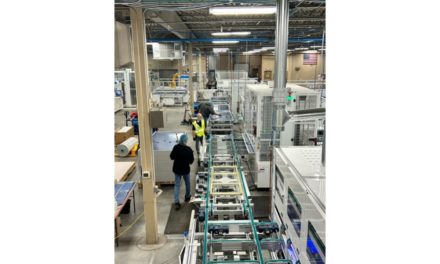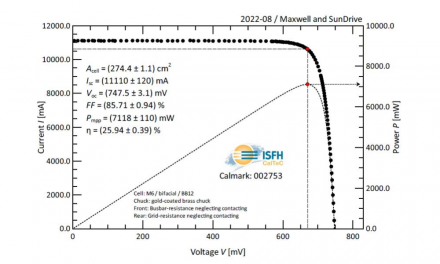- Maxwell has achieved 25.94% power conversion efficiency for monocrystalline silicon HJT solar cell
- It was reported for a full scale M6 274.4 cm² HJT cell with no silver and less indium content
- SunDrive provided its copper-plated grid lines that were optimized for direct plating process without seed layer
Solar cell production equipment supplier from China Suzhou Maxwell Technologies Co, Ltd has announced achieving 25.94% efficiency for a monocrystalline silicon heterojunction (HJT) cell using copper-plated grid lines from Australia’s SunDrive.
The company terms its attained efficiency as breakthrough under the category of ‘silver free & low indium’. In fact, companies are developing several variants of HJT technologies and attaining record level performance. For example, in March 2022, the duo reported 26.07%, but under a different category of ‘silver free’ using what it calls a mass manufacturing process (see 26.07% Efficiency Record For HJT Solar Cell).
The current efficiency is an improvement over 25.62% reported by Maxwell in April 2022 using silver-plated copper grid lines on the same type of cell (see 25.62% Efficiency For Silicon HJT Cell). It is achieved on a full scale M6 274.4 cm² HJT cell using TCO coating process of magnetron sputtering, with low indium content. SunDrive optimized its direct plating process without seed layer to allow electrode aspect ratio to improve further.
As silver and indium are the 2 topmost cost contributors to the non-silicon costs of HJT, research in the direction of making HJT cells silver free and reducing indium consumption helps in reducing the manufacturing costs of HJT technology. As for reducing the indium consumption, the industry is seriously evaluating the approach of stacking indium with other TCO layers. For details, see TaiyangNews HJT report.
Maxwell says that it’s stacked TCO approach can reduce the indium consumption by 50% compared to the standard HJT cells, with a potential to reduce the further down to 30%.
“These two processes bring the fabrication cost of HJT cells to a new low, while ensuring excellent photoelectric conversion efficiency,” stated Maxwell. The efficiency level has been certified by Germany’s Institute for Solar Energy Hamelin (ISFH).
For an overview on the latest in heterojunction solar cell technology, check the TaiyangNews HJT 2022 report, which is available for free download.














